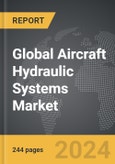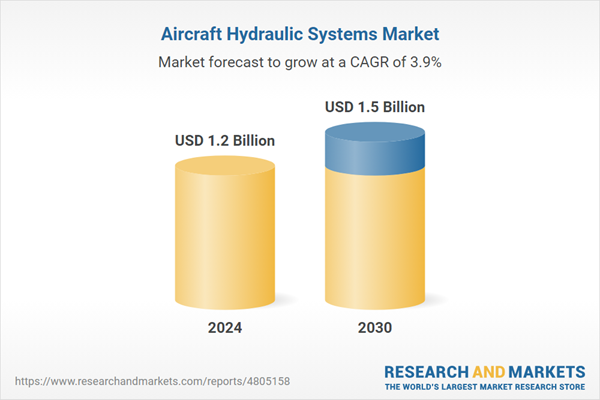The global market for Aircraft Hydraulic Systems was valued at US$1.2 Billion in 2024 and is projected to reach US$1.5 Billion by 2030, growing at a CAGR of 3.9% from 2024 to 2030. This comprehensive report provides an in-depth analysis of market trends, drivers, and forecasts, helping you make informed business decisions. The report includes the most recent global tariff developments and how they impact the Aircraft Hydraulic Systems market.
Segments: Type (Closed Center, Open Center); Component (Pumps, Reservoirs, Hydraulic Fluids, Filters, Actuators, Accumulators).
Geographic Regions/Countries: World; United States; Canada; Japan; China; Europe (France; Germany; Italy; United Kingdom; Spain; Russia; and Rest of Europe); Asia-Pacific (Australia; India; South Korea; and Rest of Asia-Pacific); Latin America (Argentina; Brazil; Mexico; and Rest of Latin America); Middle East (Iran; Israel; Saudi Arabia; United Arab Emirates; and Rest of Middle East); and Africa.
The analysts continuously track trade developments worldwide, drawing insights from leading global economists and over 200 industry and policy institutions, including think tanks, trade organizations, and national economic advisory bodies. This intelligence is integrated into forecasting models to provide timely, data-driven analysis of emerging risks and opportunities.
Global Aircraft Hydraulic Systems Market - Key Trends and Drivers Summarized
What Are Aircraft Hydraulic Systems and Why Are They Crucial?
Aircraft hydraulic systems are integral to the operation of modern airplanes, providing the necessary power to control various mechanical components essential for flight. These systems operate the aircraft’s landing gear, flaps, ailerons, and brakes, ensuring smooth and responsive maneuverability. Hydraulics use fluid power to perform these functions, with high-pressure fluids transferring energy to different parts of the aircraft. The reliability and efficiency of hydraulic systems are crucial for maintaining the safety and performance of aircraft, particularly during takeoff and landing, which are the most critical phases of flight. The components of these systems, including pumps, actuators, reservoirs, and valves, must be meticulously maintained and regularly inspected to prevent failures that could compromise the aircraft’s operational integrity.How Have Technological Advancements Transformed Hydraulic Systems?
Technological advancements have significantly enhanced the capabilities and reliability of aircraft hydraulic systems. Innovations in hydraulic fluid technology, such as the development of synthetic fluids, have improved performance by reducing the risk of overheating and increasing resistance to degradation. The integration of smart sensors and IoT technology into hydraulic systems allows for real-time monitoring and diagnostics, enabling predictive maintenance and reducing the likelihood of unexpected failures. Advanced manufacturing techniques, including 3D printing, have also revolutionized the production of hydraulic components, allowing for more precise and lightweight parts. These technologies contribute to the overall efficiency and reliability of hydraulic systems, making modern aircraft more robust and capable of handling the demands of contemporary aviation.What Challenges Are Associated with Implementing Advanced Hydraulic Systems?
Implementing advanced hydraulic systems in aircraft involves navigating several challenges, including stringent regulatory requirements, technical integration, and the need for ongoing innovation. Regulatory bodies such as the FAA and EASA impose rigorous standards that hydraulic systems must meet to ensure safety and performance, necessitating extensive testing and certification processes. Technical challenges include ensuring the compatibility of new hydraulic technologies with existing aircraft systems and infrastructure. This often requires significant engineering efforts to integrate advanced components seamlessly. Additionally, the development of hydraulic systems must balance performance with cost-effectiveness, requiring continuous innovation to produce reliable and affordable solutions. Environmental concerns also drive the need for hydraulic systems that minimize ecological impact, further complicating the development process. Addressing these challenges is crucial for the successful deployment and operation of modern hydraulic systems in aviation.What Factors Are Driving the Growth in the Aircraft Hydraulic Systems Market?
The growth in the aircraft hydraulic systems market is driven by several factors, including technological advancements, increasing global air traffic, and the rising demand for fuel-efficient and reliable aircraft. Innovations in hydraulic fluid technology and smart sensors are propelling the market forward by enhancing system performance and enabling predictive maintenance. The growing number of new aircraft deliveries, driven by rising air travel demand, necessitates the development of advanced hydraulic systems to meet modern operational requirements. Additionally, the need to retrofit and upgrade older aircraft with state-of-the-art hydraulic components creates significant market opportunities. Collaboration between aerospace manufacturers and technology firms fosters innovation, ensuring the continuous evolution of hydraulic systems to meet the industry’s needs. The emphasis on reducing maintenance costs and improving operational efficiency further accelerates the adoption of advanced hydraulic solutions. Moreover, the expansion of urban air mobility (UAM) and the development of electric and hybrid aircraft are generating new demand for specialized hydraulic systems, contributing to the dynamic growth of this market.Report Scope
The report analyzes the Aircraft Hydraulic Systems market, presented in terms of units. The analysis covers the key segments and geographic regions outlined below.Segments: Type (Closed Center, Open Center); Component (Pumps, Reservoirs, Hydraulic Fluids, Filters, Actuators, Accumulators).
Geographic Regions/Countries: World; United States; Canada; Japan; China; Europe (France; Germany; Italy; United Kingdom; Spain; Russia; and Rest of Europe); Asia-Pacific (Australia; India; South Korea; and Rest of Asia-Pacific); Latin America (Argentina; Brazil; Mexico; and Rest of Latin America); Middle East (Iran; Israel; Saudi Arabia; United Arab Emirates; and Rest of Middle East); and Africa.
Key Insights:
- Market Growth: Understand the significant growth trajectory of the Closed Center Systems segment, which is expected to reach US$1.0 Billion by 2030 with a CAGR of a 4.1%. The Open Center Systems segment is also set to grow at 3.5% CAGR over the analysis period.
- Regional Analysis: Gain insights into the U.S. market, valued at $320.9 Million in 2024, and China, forecasted to grow at an impressive 6.6% CAGR to reach $311.5 Million by 2030. Discover growth trends in other key regions, including Japan, Canada, Germany, and the Asia-Pacific.
Why You Should Buy This Report:
- Detailed Market Analysis: Access a thorough analysis of the Global Aircraft Hydraulic Systems Market, covering all major geographic regions and market segments.
- Competitive Insights: Get an overview of the competitive landscape, including the market presence of major players across different geographies.
- Future Trends and Drivers: Understand the key trends and drivers shaping the future of the Global Aircraft Hydraulic Systems Market.
- Actionable Insights: Benefit from actionable insights that can help you identify new revenue opportunities and make strategic business decisions.
Key Questions Answered:
- How is the Global Aircraft Hydraulic Systems Market expected to evolve by 2030?
- What are the main drivers and restraints affecting the market?
- Which market segments will grow the most over the forecast period?
- How will market shares for different regions and segments change by 2030?
- Who are the leading players in the market, and what are their prospects?
Report Features:
- Comprehensive Market Data: Independent analysis of annual sales and market forecasts in US$ Million from 2024 to 2030.
- In-Depth Regional Analysis: Detailed insights into key markets, including the U.S., China, Japan, Canada, Europe, Asia-Pacific, Latin America, Middle East, and Africa.
- Company Profiles: Coverage of players such as Arkwin Industries Inc., Beaver Aerospace & Defense, Inc., Eaton Corporation PLC, Liebherr-International AG, Moog, Inc. and more.
- Complimentary Updates: Receive free report updates for one year to keep you informed of the latest market developments.
Some of the 41 companies featured in this Aircraft Hydraulic Systems market report include:
- Arkwin Industries Inc.
- Beaver Aerospace & Defense, Inc.
- Eaton Corporation PLC
- Liebherr-International AG
- Moog, Inc.
- Parker Hannifin Corporation
- Safran
- Triumph Group, Inc.
- United Technologies Corporation (UTC)
- Woodward, Inc.
Tariff Impact Analysis: Key Insights for 2025
Global tariff negotiations across 180+ countries are reshaping supply chains, costs, and competitiveness. This report reflects the latest developments as of April 2025 and incorporates forward-looking insights into the market outlook.The analysts continuously track trade developments worldwide, drawing insights from leading global economists and over 200 industry and policy institutions, including think tanks, trade organizations, and national economic advisory bodies. This intelligence is integrated into forecasting models to provide timely, data-driven analysis of emerging risks and opportunities.
What’s Included in This Edition:
- Tariff-adjusted market forecasts by region and segment
- Analysis of cost and supply chain implications by sourcing and trade exposure
- Strategic insights into geographic shifts
Buyers receive a free July 2025 update with:
- Finalized tariff impacts and new trade agreement effects
- Updated projections reflecting global sourcing and cost shifts
- Expanded country-specific coverage across the industry
Table of Contents
I. METHODOLOGYII. EXECUTIVE SUMMARY2. FOCUS ON SELECT PLAYERSIII. MARKET ANALYSISSOUTH KOREAREST OF ASIA-PACIFICARGENTINABRAZILMEXICOREST OF LATIN AMERICAIRANISRAELSAUDI ARABIAUNITED ARAB EMIRATESREST OF MIDDLE EASTIV. COMPETITION
1. MARKET OVERVIEW
3. MARKET TRENDS & DRIVERS
4. GLOBAL MARKET PERSPECTIVE
UNITED STATES
CANADA
JAPAN
CHINA
EUROPE
FRANCE
GERMANY
ITALY
UNITED KINGDOM
SPAIN
RUSSIA
REST OF EUROPE
ASIA-PACIFIC
AUSTRALIA
INDIA
LATIN AMERICA
MIDDLE EAST
AFRICA
Companies Mentioned (Partial List)
A selection of companies mentioned in this report includes, but is not limited to:
- Arkwin Industries Inc.
- Beaver Aerospace & Defense, Inc.
- Eaton Corporation PLC
- Liebherr-International AG
- Moog, Inc.
- Parker Hannifin Corporation
- Safran
- Triumph Group, Inc.
- United Technologies Corporation (UTC)
- Woodward, Inc.
Table Information
| Report Attribute | Details |
|---|---|
| No. of Pages | 244 |
| Published | April 2025 |
| Forecast Period | 2024 - 2030 |
| Estimated Market Value ( USD | $ 1.2 Billion |
| Forecasted Market Value ( USD | $ 1.5 Billion |
| Compound Annual Growth Rate | 3.9% |
| Regions Covered | Global |









